Hema's Guide To Towing Off Road
Once you veer off the black-top and reach the end of the graded-gravel roads, obstacles are made all the more challenging with a trailer in tow. Of course, one of the main advantages to a svelte camper over a hulking caravan is that they can be taken to such remote, hard to access spots. With a nimble trailer and a capable 4WD you'll be able to manoeuvre your way out to some of Australia's most idyllic locations, just be sure you know what you're getting into.
The Fundamentals
If you have experience driving off-road without a trailer then you will have a good understanding of the fundamentals. However, there are extra considerations with a trailer in tow; keeping your trailer on line when straddling a rut and accounting for the clearance of an angled hitch are just a couple of that have been known to catch drivers unawares.
Rocks
Balance and traction are the keys to rocky terrain. If your trailer loses balance and slides off a precarious perch it can pull your vehicle along for the ride, so pay close attention to your approaches and always consider the line your trailer will be following. Your clearance may not be what you're used to due to the bending of the hitch, in which case you can pile logs and stones at the base of a step to provide a bit of help. Steer into the lean if it feels like your vehicle is going to tip over, this might be enough to correct the unbalance.
On loose rocks or shale your best bet is to maintain a constant and manageable speed. Sudden braking and sharp cornering can cause you to lose traction, which will only be worsened by the weight on the hitch. Keep your tyres on the worn part of the track where there fewer loose rocks and avoid the outer shoulder where the slippery stuff tends to build up.
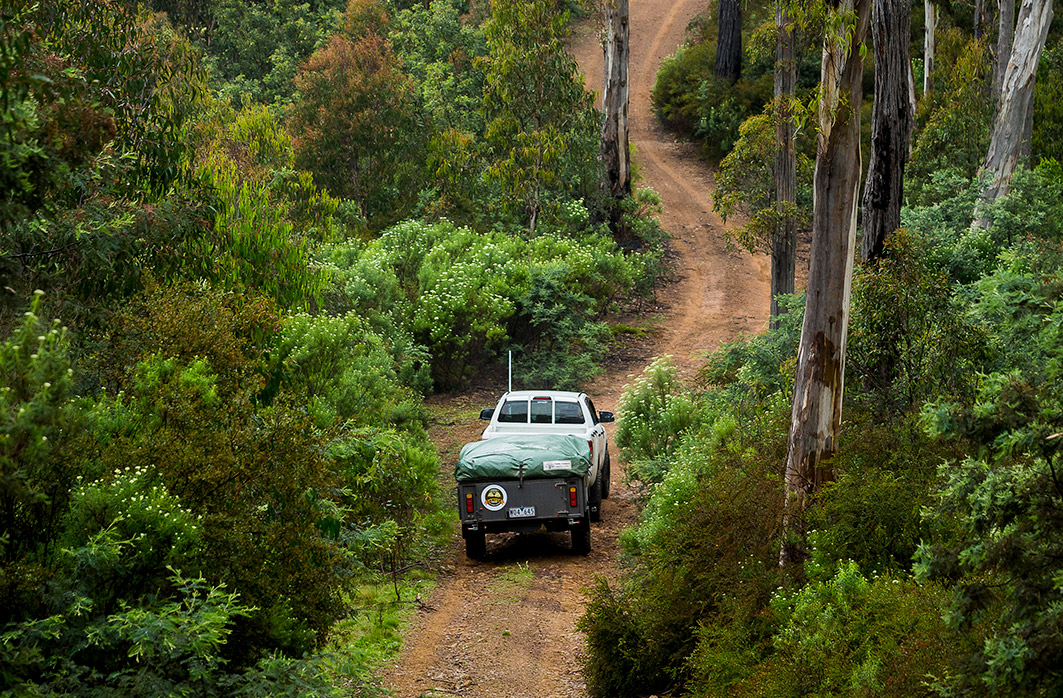 Sand
Sand
Be alert and approach with your tyre pressures sufficiently lowered. Try to drive in any existing ruts where the sand is compacted down, and attempt to have your trailer following in the tracks of your vehicle. When you encounter a dune you'll do well to go straight up or down, as the angled sand can be slippery. This is even more important when you have a trailer in tow, as it can slide away and pull your vehicle with it.
Sand will dramatically increase the resistance on your wheels, which means you can quickly loose momentum while shifting gears – if it's necessary, try to change swiftly and smoothly. Similarly, the additional braking power of your trailer can be a hindrance. By backing off the trailer brakes you won't lose your ability to stop, you may just decrease your chances of whiplash when you plant your foot.
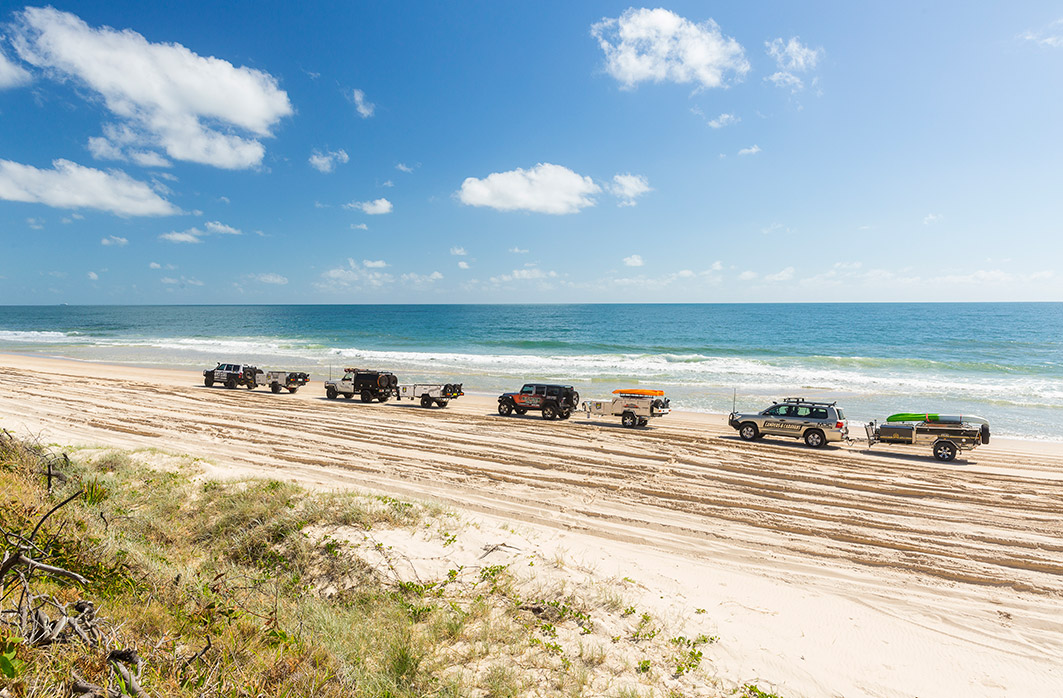 Rivers
Rivers
River crossings can be one of the most exhilarating parts of a trip and, let's be honest, make for great photos. Even if you're tackling the same river you crossed a week earlier you need to take all the same precautions, as you'll seldom have the same experience twice on the same river. Water depth and flow will differ, and the driving surface may have shifted too.
Before you head out make sure everything is sealed as well as possible. Check for any spots where water might enter the engine, like a loose dipstick, and seal them as best you can. A snorkel will dramatically improve your chances in deeper water, and any spares should be kept in water-tight plastic bags.
When you reach the watercourse in question, the best way to suss it out is to wade through, the old human-water-gauge, assuming it's safe to do so. Also be mindful of undercurrents and any boulders or low spots concealed beneath. Once you're comfortable with the flow, check the entry and exit points, make sure they're not too steep and the surfaces aren't too loose, and be wary that if you can't pick a straight line your turning circle will be reduced with a wet trailer in tow.
If you've been on the road a while, it's a good idea to let your engine cool before dipping it in. There are a number of reasons for this, which include the effectiveness of seals and rapid cooling of metals. You also don't want cooling fans running, as they can be damaged by the water – it's a good idea to turn off your air-con while you're at it.

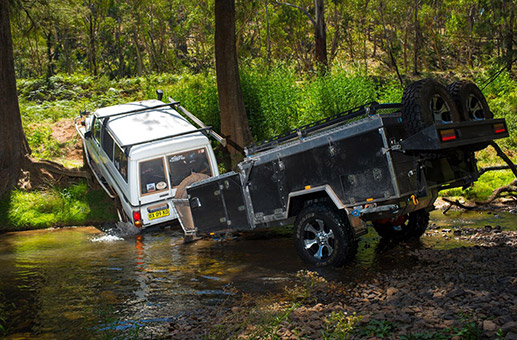 Once you've picked your line and your engine's cooled off you can strap on a wading tarp or water bra, which will help prevent radiator damage and engine flooding. Next, a few deep breaths, pop it into low-range, engage lockers (if you have them) and ease it in. You're looking to enter the water gently, so as to reduce splashing and produce a gentle bow wave. Stalling is to be avoided, it can allow water to get in where it shouldn't, so you'll want to pick one gear and stick with it. If you get stuck keep the engine running so that water doesn't get drawn into the exhaust and creep in where it's not wanted.
Once you've picked your line and your engine's cooled off you can strap on a wading tarp or water bra, which will help prevent radiator damage and engine flooding. Next, a few deep breaths, pop it into low-range, engage lockers (if you have them) and ease it in. You're looking to enter the water gently, so as to reduce splashing and produce a gentle bow wave. Stalling is to be avoided, it can allow water to get in where it shouldn't, so you'll want to pick one gear and stick with it. If you get stuck keep the engine running so that water doesn't get drawn into the exhaust and creep in where it's not wanted.
Your trailer is more likely to be buoyant than your vehicle, and can pull you off-course if there's a strong current. Some folk will load a little extra weight onto the trailer to stop it floating, just make sure there's nothing valuable in there in case it gets submerged.
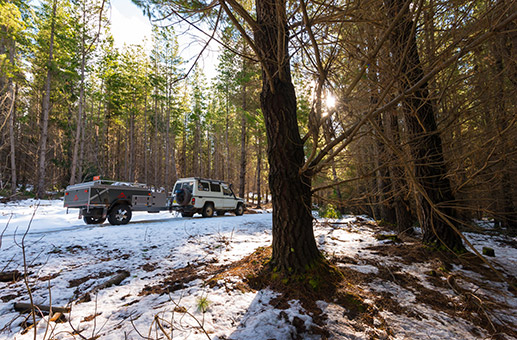 Snow
Snow
In some parts of the world snow is common but down here in Australia it's something that many drivers have never encountered. Needless to say, it presents its own unique challenges. First of all, snow chains; be sure to carry them if you expect to encounter the white stuff and know how to put them on. Keep in mind that chains are a useful traction aid on serious off-road ice and snow, but are not a miracle solution and are not always necessary. If you're just out for a day in the high country then you may not actually have a need for them, though it is a legal requirement to carry them in some ski areas and alpine resorts.
Snow is best tackled with low tyre pressures. Start off at around 25psi and then lower if need be. If there are hard-packed tracks from previous vehicles then it's a good idea to stick to those, they will provide better traction and direction control. Drive steadily and avoid aggressive breaking, acceleration and hard cornering that could result in a loss of traction. A blanket of snow can also make it hard to see any obstacles that lie beneath. Keep an eye out for tell-tale signs, such as splintered tree stumps that may indicate a fallen tree across the track.
Always carry a long handled shovel and traction boards, such as MaxTrax, when driving in snow. Be mindful that alpine environments can be harsh, so take plenty of warm clothing, food and emergency gear. If you're staying put for a long time, remember that low temperatures can make diesel fuel thick and can result in difficulty starting the engine. Some areas sell alpine diesel, which is more resistant to cold, or you can purchase a cold-flow additive to help out.
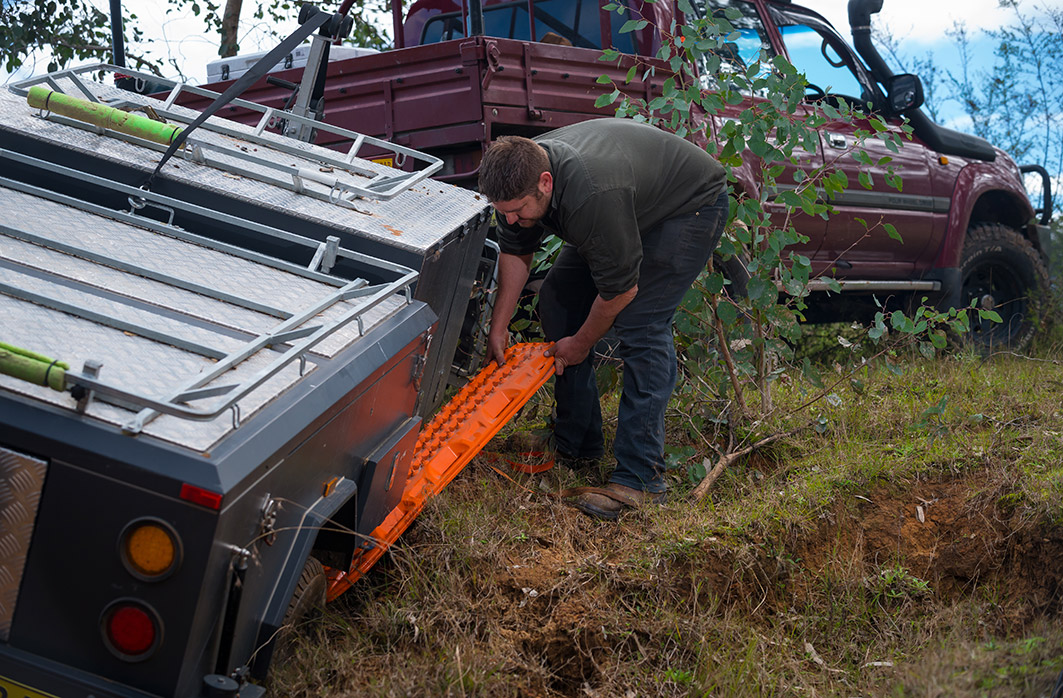 Inclines
Inclines
Steep lines require a considered approach followed by a committed execution. The additional weight of a trailer can exert a lot of stress on your vehicle on steep inclines, so it's best to pick as straight a line as you can. On loose surfaces it can be useful to drive forward and then roll backward a few times to compact your driving line, just be careful not to jackknife the trailer.
Pop it into low-range and pick one gear that will give you enough grunt to get up the incline, you want to avoid the loss of inertia that comes with changing gears. When you're going up the transfer of weight will often unload the front suspension, which will make it harder to steer and brake.
On the way down it's wise to use low gears to avoid excessive braking that could send your vehicle into a slide. Applying trailer brakes independently can lessen the adverse effects of all that weight on the hitch. Avoid using the clutch, as it cancels out your engine braking and will have you barrelling down the slope in a 4WD free-fall. Lastly, if you have rear lockers then it's a good idea to engage them before heading down, as they will help to steady your back end.









0 comments